-
ORIGINAL ARTICLE12-13-2024
Nurses’ experience regarding patient safety in mobile pre-hospital care
Revista Brasileira de Enfermagem. 2024;77(5):e20230529
Abstract
ORIGINAL ARTICLENurses’ experience regarding patient safety in mobile pre-hospital care
Revista Brasileira de Enfermagem. 2024;77(5):e20230529
DOI 10.1590/0034-7167-2023-0529
Views0See moreABSTRACT
Objectives:
to understand nurses’ experience regarding patient safety in mobile pre-hospital care.
Method:
a qualitative, exploratory and descriptive study, conducted with nurses active in mobile pre-hospital care services. Semi-structured interviews were conducted, audio-graved and submitted to Bardin’s content analysis.
Results:
from four thematic categories established, nurses reported the care and management skills necessary to work in this service. They demonstrated a commitment to ensuring safe care for patients, staff and spectators. They highlighted the actions taken to prevent and mitigate incidents. However, they based their experiences on practice protocols and individual actions, expressing the need to improve knowledge about patient safety.
Final Considerations:
mobile pre-hospital care nurses’ experience in relation to patient safety was limited, suggesting the need for training on the subject, alignment of work processes and implementation of strategies, aiming to guarantee safe care.
-
ORIGINAL ARTICLE12-13-2024
Stress in nursing workers caring for people with COVID-19
Revista Brasileira de Enfermagem. 2024;77(5):e20230542
Abstract
ORIGINAL ARTICLEStress in nursing workers caring for people with COVID-19
Revista Brasileira de Enfermagem. 2024;77(5):e20230542
DOI 10.1590/0034-7167-2023-0542
Views1See moreABSTRACT
Objectives:
to analyze stress from the perspective of nursing workers caring for people with COVID-19 in a public hospital in the Recôncavo region of Bahia.
Methods:
this is an exploratory qualitative study, conducted through semi-structured interviews. The data were analyzed using word clouds, similarity trees, and content analysis.
Results:
nursing workers were exposed to stress while attending to patients with COVID-19. The reported stressors in the workplace included: work overload, lack of planning, speed in performing tasks, fatigue, lack of participation in decision-making, lack of support from management, technological changes, excessive responsibility without preparation, interpersonal conflicts, and professional undervaluation.
Conclusions:
exposure to these stressors leads to emotional exhaustion and demotivation, which were intensified during the COVID-19 pandemic.
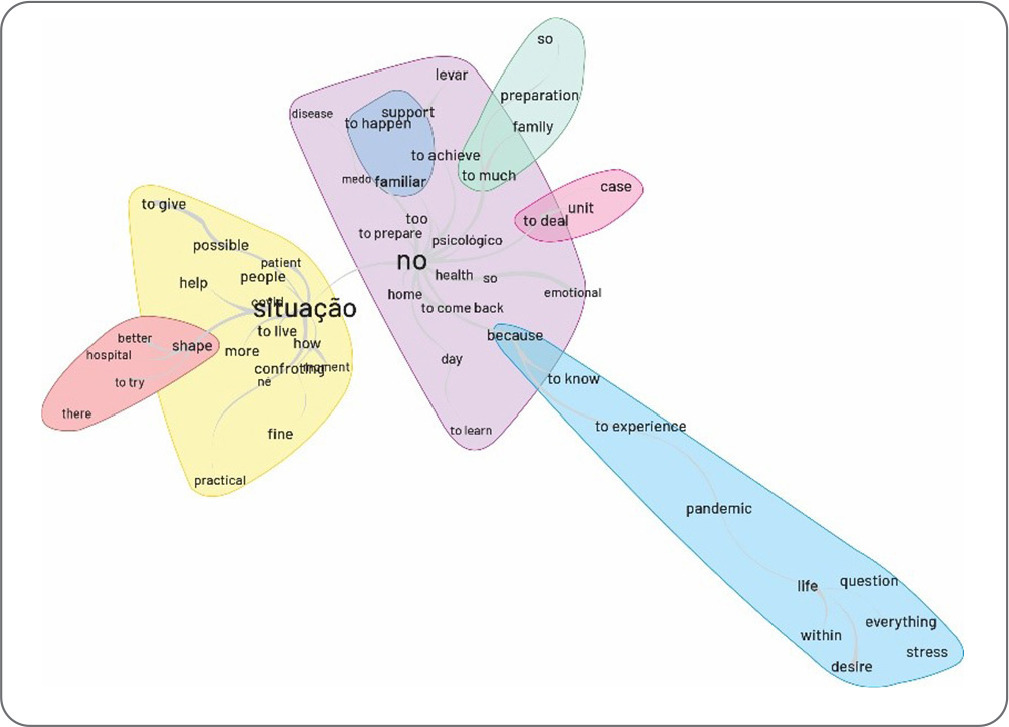
-
ORIGINAL ARTICLE12-13-2024
Knowledge and attitudes of nursing students regarding the sexuality of older adults: a quasi-experimental study
Revista Brasileira de Enfermagem. 2024;77(5):e20240011
Abstract
ORIGINAL ARTICLEKnowledge and attitudes of nursing students regarding the sexuality of older adults: a quasi-experimental study
Revista Brasileira de Enfermagem. 2024;77(5):e20240011
DOI 10.1590/0034-7167-2024-0011
Views0See moreABSTRACT
Objectives:
to compare the knowledge and attitudes of nursing students regarding sexual behavior and sexually transmitted infections (STIs) in older adults before and after an educational intervention.
Methods:
this quasi-experimental study involved a convenience sample of 45 nursing students from a public university, conducted in three stages: pre-intervention, intervention, and post-intervention. A questionnaire was used to assess sociodemographic characteristics, academic training, and knowledge and attitudes on the topic. The intervention was an educational web conference. Paired t-test and Wilcoxon test were used for data analysis.
Results:
there was a statistically significant difference in the knowledge and attitude scores of nursing students before and after the educational intervention (p < 0.001). A significant increase was observed in the knowledge score (from 9.3 to 12.2) and attitude score (from 108 to 117.2) in the post-intervention phase.
Conclusions:
the knowledge of nursing students regarding the sexuality of older adults increased after the educational intervention, and their attitudes on the subject became more positive.
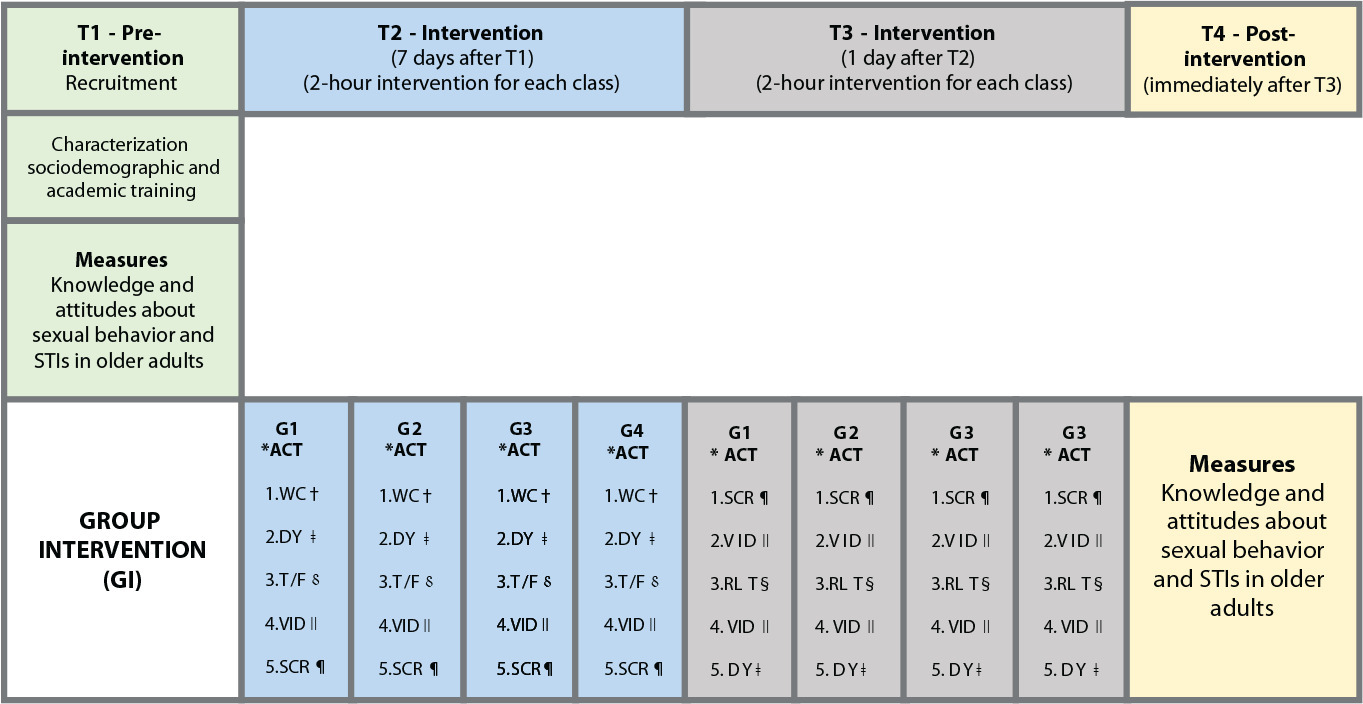
-
ORIGINAL ARTICLE12-13-2024
Educational booklet on labor and delivery: validity study
Revista Brasileira de Enfermagem. 2024;77(5):e20240138
Abstract
ORIGINAL ARTICLEEducational booklet on labor and delivery: validity study
Revista Brasileira de Enfermagem. 2024;77(5):e20240138
DOI 10.1590/0034-7167-2024-0138
Views2See moreABSTRACT
Objectives:
to develop and validate an educational booklet on labor and delivery for pregnant women.
Methods:
this methodological study involved constructing and validating a booklet based on Echer’s framework. We used the Content Validity Index and Cronbach’s alpha for content and face validation, selecting judges according to Fering’s criteria. We then conducted a clinical validation with the target population.
Results:
the booklet, developed based on evidence from an integrative review and validated by judges and the target audience, achieved global Content Validity Index of 0.919 and 0.913, respectively. After clinical validation with 22 pregnant women, it included 28 topics and 48 pages, with illustrations by a graphic designer.
Conclusions:
expert judges and the target audience considered this educational technology valid, deeming it a relevant tool for promoting the health of pregnant women.
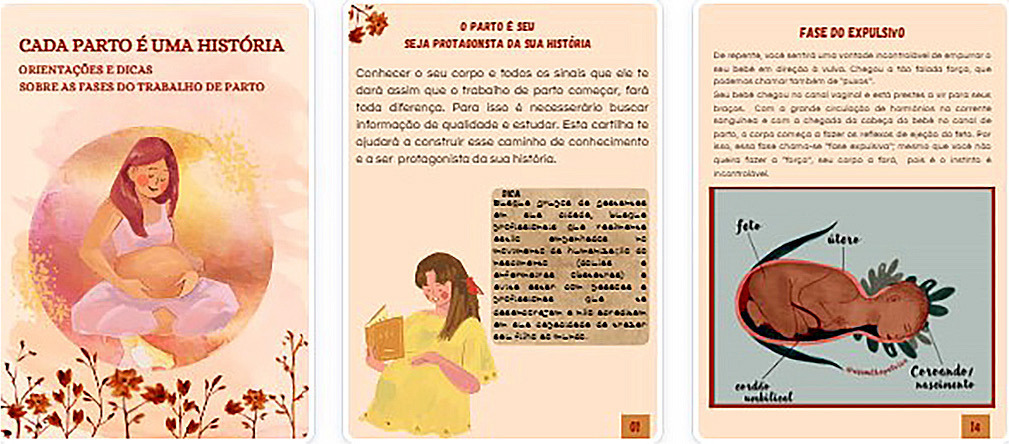
-
12-08-2024
Contexto ibero-americano da enfermagem: construindo e compartilhando conhecimento
Revista Brasileira de Enfermagem. 2024;77(1):e770101
Abstract
Contexto ibero-americano da enfermagem: construindo e compartilhando conhecimento
Revista Brasileira de Enfermagem. 2024;77(1):e770101
DOI 10.1590/0034-7167.2024770101pt
Views0Na próxima semana, acontecerão dois grandes eventos científicos em Madri e Granada (Espanha). Serão atividades internacionais, específicas e de forma muito especial, embora não exclusivas do campo ibero-americano, organizadas e desenvolvidas por duas sociedades científicas de enfermagem muito importantes, como a Associação de Enfermagem Comunitária (AEC) e a Associação Latino-Americana de Escolas e Faculdades de […]See more -
ORIGINAL ARTICLE12-08-2024
Initial nipple damages in breastfeeding women: analysis of photographic images and clinical associations
Revista Brasileira de Enfermagem. 2024;77(1):e20220773
Abstract
ORIGINAL ARTICLEInitial nipple damages in breastfeeding women: analysis of photographic images and clinical associations
Revista Brasileira de Enfermagem. 2024;77(1):e20220773
DOI 10.1590/0034-7167-2022-0773
Views0See moreABSTRACT
Objective:
to analyze the initial nipple damage degree by breastfeeding practice and to associate findings with clinical manifestations of breastfeeding women.
Methods:
a retrospective, cross-sectional study with primary data and photographic images database from two randomized clinical trials. Photographic images were analyzed by two independent evaluators using the Nipple Trauma Score. For analysis, the chi-square, Mann-Whitney tests and Kappa coefficient were applied.
Results:
115 breastfeeding women and their respective 186 photographic images were analyzed. The degree of agreement of evaluators using the Nipple Trauma Score was 93.6%. The nipple pain score during breastfeeding was moderate and compromised more than 25% of the nipple surface area.
Conclusions:
assistance to breastfeeding women should prioritize nipple pain intensity instead of the nipple damage size.
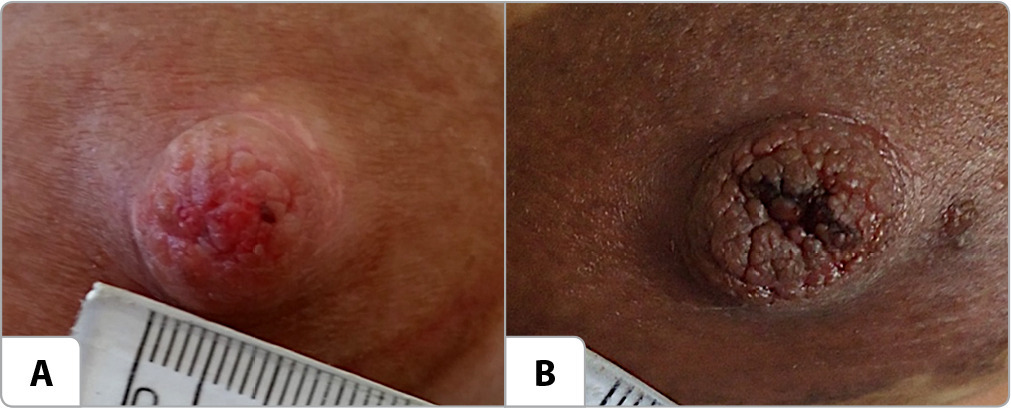
-
REVIEW12-08-2024
Interventions for Strengthening General Self-Efficacy Beliefs in College Students: An Integrative Review
Revista Brasileira de Enfermagem. 2024;77(1):e20230192
Abstract
REVIEWInterventions for Strengthening General Self-Efficacy Beliefs in College Students: An Integrative Review
Revista Brasileira de Enfermagem. 2024;77(1):e20230192
DOI 10.1590/0034-7167-2023-0192
Views0See moreABSTRACT
Objective:
To assess the evidence regarding the effectiveness of interventions aimed at strengthening self-efficacy beliefs in college students.
Methods:
Integrative Review conducted on the Lilacs, PubMed, CinahL, Cochrane Collaboration Databases, Scopus, and PsycInfo databases. The methodological quality of the studies was assessed using tools proposed by the Joanna Briggs Institute, and the results were analyzed descriptively.
Results:
Out of the 10 selected studies, six demonstrated that interventions aimed at strengthening self-efficacy were effective (Levels of Evidence II and III), and four revealed contrary results (Levels of Evidence I and II). Programs aimed at enhancing self-efficacy should include content on positive mental health, psychoeducation strategies, cover a period of eight to twelve weeks, and consider the completion of homework assignments.
Conclusion:
The synthesis of evidence pointed to pathways for building an effective self-efficacy strengthening program to be implemented in universities.
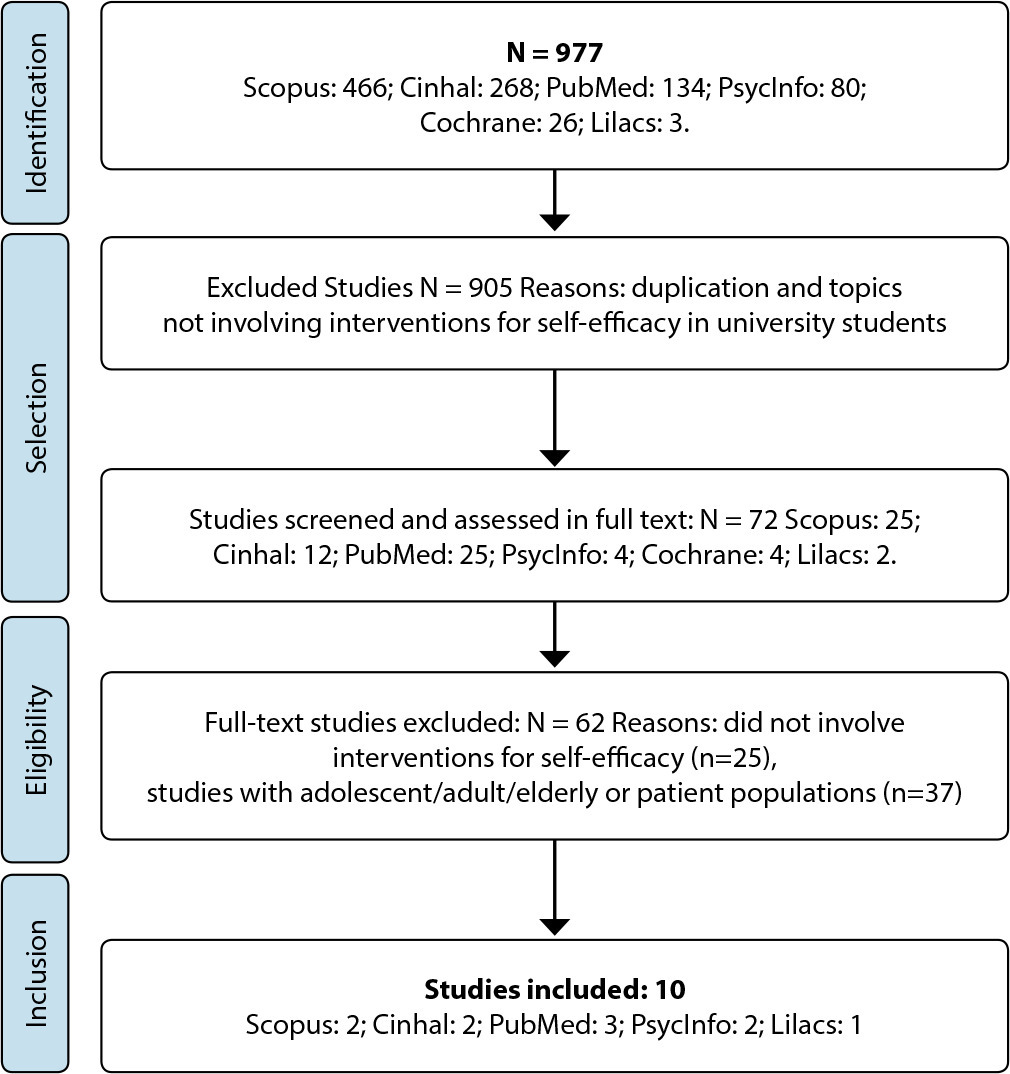
-
REVIEW12-08-2024
Common mental disorders in hematopoietic stem cell transplant patients: a scoping review
Revista Brasileira de Enfermagem. 2024;77(1):e20220581
Abstract
REVIEWCommon mental disorders in hematopoietic stem cell transplant patients: a scoping review
Revista Brasileira de Enfermagem. 2024;77(1):e20220581
DOI 10.1590/0034-7167-2022-0581
Views0See moreABSTRACT
Objective:
to map common recurrent mental disorders in patients undergoing hematopoietic stem cell transplantation.
Methods:
this is a scoping review carried out in January 2022 in electronic databases and repositories of dissertations and thesis. Studies that answered the research question, met the objective of the study and were available in full electronically, in any language, were included.
Results:
the sample consisted of 28 studies, 14 of which were published in the United States of America. The common mental disorders found were depressive, anxiety, post-traumatic stress and mood disorders. Twenty symptoms were mentioned, among the most prevalent are fatigue and sleep disorders/insomnia.
Conclusions:
the difficulty and importance of carrying out the differential diagnosis of these disorders were highlighted, since their symptoms can be confused with other health problems and have a strong potential to interfere with patients’ evolution.
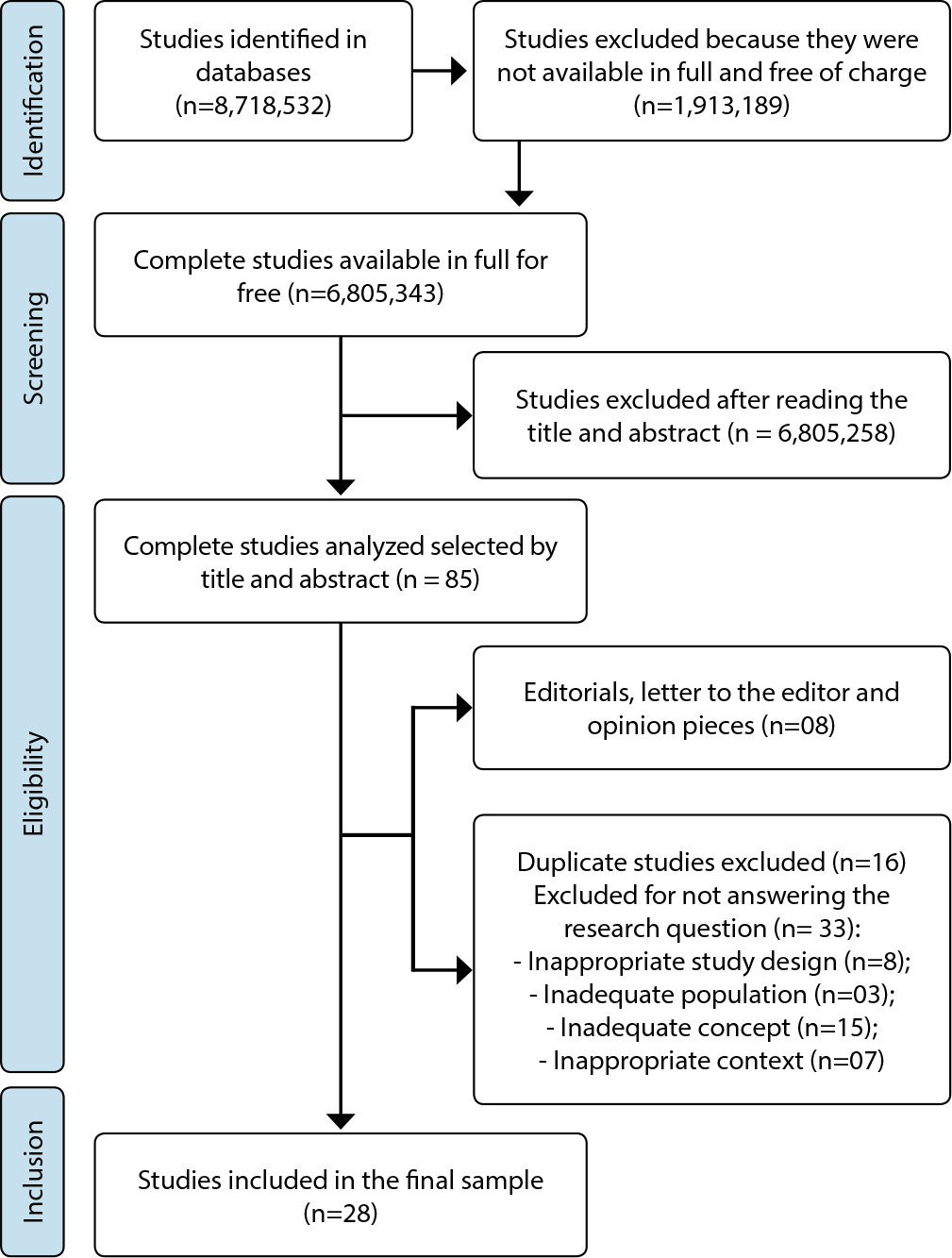
-
REVIEW02-25-2022
What do we know about flushing for intravenous catheter maintenance in hospitalized adults?
Revista Brasileira de Enfermagem. 2022;75(5):e20210418
Abstract
REVIEWWhat do we know about flushing for intravenous catheter maintenance in hospitalized adults?
Revista Brasileira de Enfermagem. 2022;75(5):e20210418
DOI 10.1590/0034-7167-2021-0418
Views0See moreABSTRACT
Objective:
to evidence the use of flushing to prevent complications from intravenous therapy.
Methods:
an integrative review in databases, using descriptors and selection criteria. Data were collected in 12 articles using an instrument and later classified, summarized and aggregated for knowledge synthesis.
Results:
it was evident that: the pre-filled syringe resulted in a lower occurrence of catheter obstruction; irregular flushing frequency caused advanced phlebitis; the use of Venous Arterial Blood Management Protection (VAMP) generated a lower incidence of blood infection; heparinized solution did not result in a lower central catheter failure rate; flushing volume and frequency were not predictors of catheter failure; flushing practice was not shown to be incorporated among professionals.
Conclusion:
there are disagreements about the volume, frequency, solution and devices used in flushing. New technologies can reduce complications such as obstruction and infection.
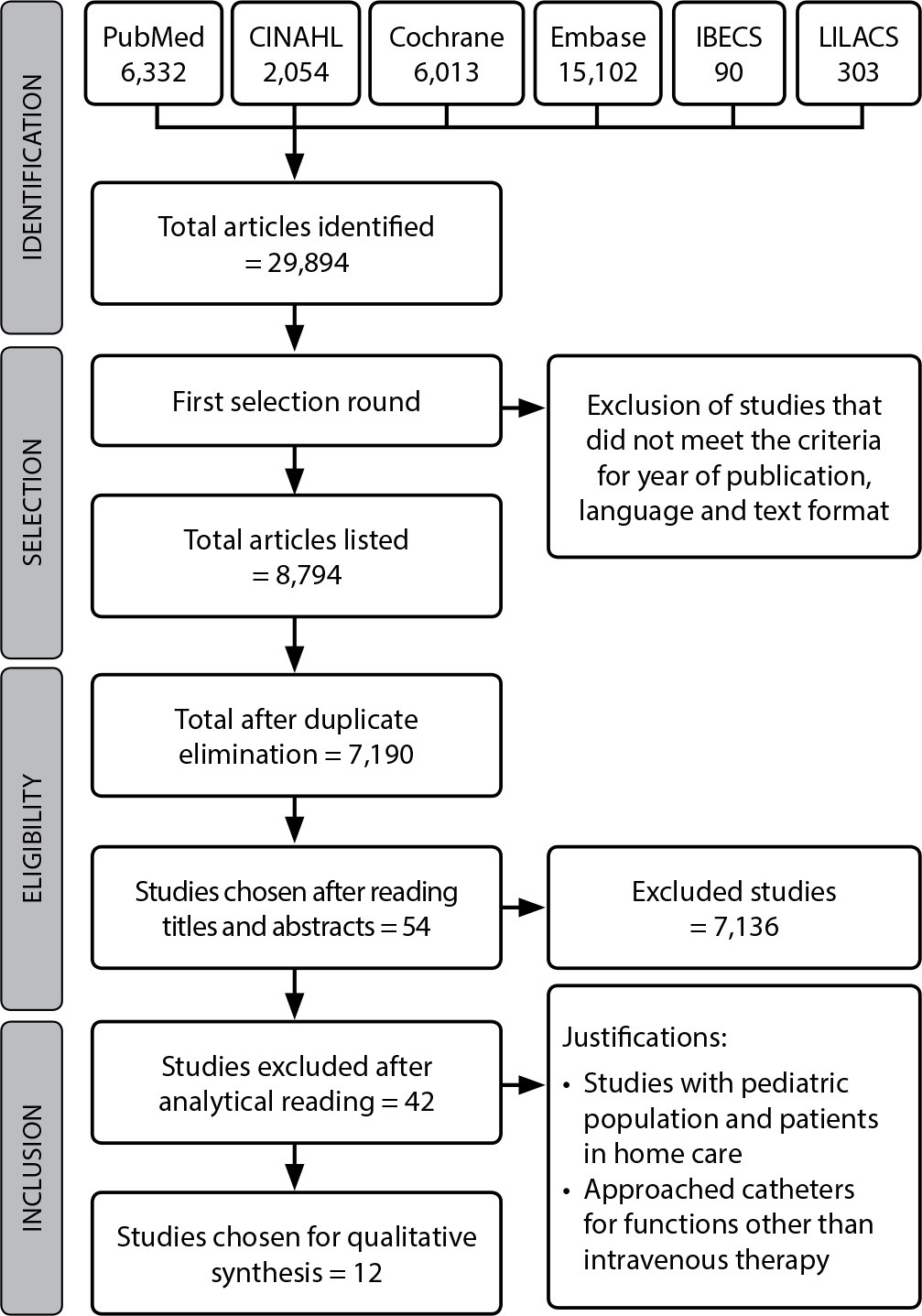
-
ORIGINAL ARTICLE12-13-2019
Prenatal care satisfaction: perception of caregivers with diabetes mellitus
Revista Brasileira de Enfermagem. 2019;72:305-311
Abstract
ORIGINAL ARTICLEPrenatal care satisfaction: perception of caregivers with diabetes mellitus
Revista Brasileira de Enfermagem. 2019;72:305-311
DOI 10.1590/0034-7167-2018-0978
Views0See moreABSTRACT
Objective:
to understand the satisfaction of pregnant women with diabetes who took insulin during pregnancy and prenatal care performed through outpatient and inpatient follow-up.
Method:
a qualitative approach with analysis of 30 pregnant women who underwent prenatal care and participated in a clinical trial study carried out by the research group of the Perinatal Diabetes Research Center of the Hospital das Clínicas, of the Faculdade de Medicina de Botucatu. The data were collected through interviews and analyzed from content analysis.
Results:
from the category Satisfaction, the following subcategories emerged: facilities and difficulties faced in prenatal care performed through outpatient or inpatient follow-up, demonstrating that the pregnant women were satisfied with the prenatal care offered regardless of the type of follow-up.
Conclusion:
there was satisfaction in both care, but in outpatient care some structural, technical and administrative difficulties were identified, requiring reassessment, in order to guarantee service agility.
-
ORIGINAL ARTICLE07-17-2020
Nursing process implantation in mental health: a convergent-care research
Revista Brasileira de Enfermagem. 2020;73:e20190579
Abstract
ORIGINAL ARTICLENursing process implantation in mental health: a convergent-care research
Revista Brasileira de Enfermagem. 2020;73:e20190579
DOI 10.1590/0034-7167-2019-0579
Views0See moreABSTRACT
Objective:
to understand the perception of nurses and their needs regarding Nursing Process implantation in a long-term psychiatric hospitalization unit.
Method:
a convergent care research, carried out in a psychiatric institute in Rio de Janeiro, with 13 nurses. Data were produced between May/2016 and August/2017, with observation in a field diary, semi-structured interviews and groups. Data were analyzed regarding content, theme and by the software NVivo.
Results:
three thematic categories were developed: Knowledge and practices of participants on Systematization of Nursing Care, Nursing Process and classification system; Convergence points: Nursing Process in practice and research; Challenges of Nursing Process implantation in mental health.
Final considerations:
implantation was perceived by nurses as a way to be constructed: in the stages of Nursing Process, in handling classifications, but mainly in articulation with the Brazilian National Mental Health Policy.

-
ORIGINAL ARTICLE08-15-2022
Reiki for promotion of health and sleep quality in hospital nursing professionals
Revista Brasileira de Enfermagem. 2022;75(5):e20210535
Abstract
ORIGINAL ARTICLEReiki for promotion of health and sleep quality in hospital nursing professionals
Revista Brasileira de Enfermagem. 2022;75(5):e20210535
DOI 10.1590/0034-7167-2021-0535
Views0See moreABSTRACT
Objectives:
to know the repercussions of a Reiki therapy intervention on the sleep quality of nursing professionals working in a general hospital.
Methods:
a qualitative-quantitative study conducted with 16 professionals from the nursing team of a hospital in northwest Paraná, who participated in an intervention consisting of six weekly Reiki sessions. Data collected from September, 2019 to March, 2020 through semi-structured interviews and application of the Pittsburgh Sleep Quality Index before and after the intervention.
Results:
better sleep quality, characterized by a reduction in the time to fall asleep and in nightmares, and an increase in sleeping hours.
Conclusions:
reiki intervention had a positive impact on the sleep quality of participants.
-
ORIGINAL ARTICLE02-10-2020
Safety of patients with mental disorders: a collective construction of strategies
Revista Brasileira de Enfermagem. 2020;73(1):e20170905
Abstract
ORIGINAL ARTICLESafety of patients with mental disorders: a collective construction of strategies
Revista Brasileira de Enfermagem. 2020;73(1):e20170905
DOI 10.1590/0034-7167-2017-0905
Views0See moreABSTRACT
Objective:
to describe risk management implementation in the safety of patients with mental disorders through action research.
Method:
an action research carried out with a multidisciplinary team from a reference hospital in mental health in Southeast Brazil.
Results:
three strategies considered as managerial technologies for the mentally ill patient were developed: risk management diagram for patient safety; patient safety protocols; and textual proposal of software for internal management of incident notifications.
Final considerations:
this action research allowed a collective discussion by the whole multidisciplinary team, enabling strategy drafting for risk management implementation and improvement of care quality in the safety of patients with mental disorders at the study site.
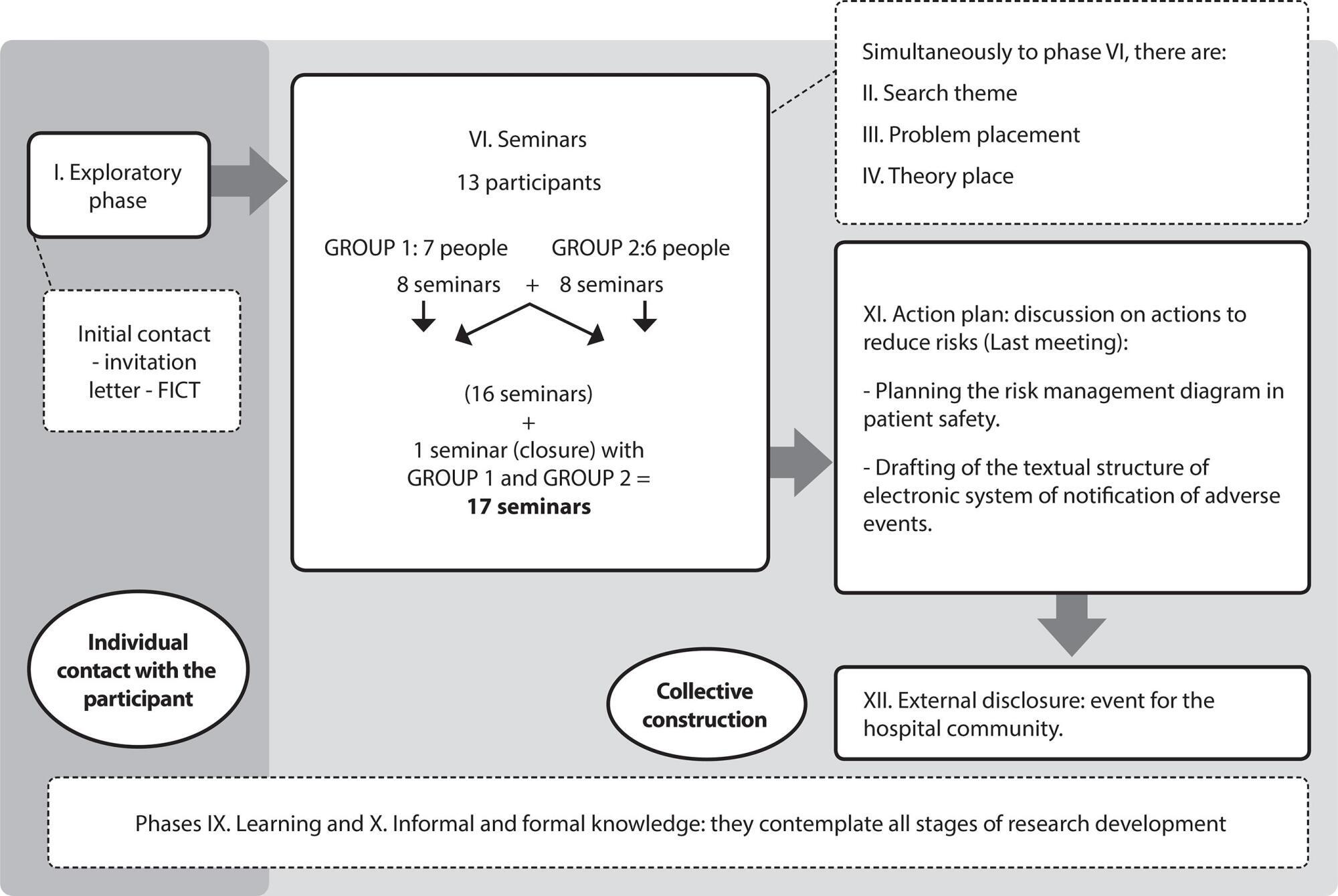
-
ORIGINAL ARTICLE05-09-2022
Beyond technology: Can artificial intelligence support clinical decisions in the prediction of sepsis?
Revista Brasileira de Enfermagem. 2022;75(5):e20210586
Abstract
ORIGINAL ARTICLEBeyond technology: Can artificial intelligence support clinical decisions in the prediction of sepsis?
Revista Brasileira de Enfermagem. 2022;75(5):e20210586
DOI 10.1590/0034-7167-2021-0586
Views0See moreABSTRACT
Objective:
To analyze the critical alarms predictors of clinical deterioration/sepsis for clinical decision making in patients admitted to a reference hospital complex.
Methods:
An observational retrospective cohort study. The Machine Learning (ML) tool, Robot Laura®, scores changes in vital parameters and lab tests, classifying them by severity. Inpatients and patients over 18 years of age were included.
Results:
A total of 122,703 alarms were extracted from the platform, classified as 2 to 9. The pre-selection of critical alarms (6 to 9) indicated 263 urgent alerts (0.2%), from which, after filtering exclusion criteria, 254 alerts were delimited for 61 inpatients. Patient mortality from sepsis was 75%, of which 52% was due to sepsis related to the new coronavirus. After the alarms were answered, 82% of the patients remained in the sectors.
Conclusions:
Far beyond technology, ML models can speed up assertive clinical decisions by nurses, optimizing time and specialized human resources.
-
ORIGINAL ARTICLE06-04-2021
Information that (de)motivate women’s decision making on Planned Home Birth
Revista Brasileira de Enfermagem. 2021;74(4):e20200404
Abstract
ORIGINAL ARTICLEInformation that (de)motivate women’s decision making on Planned Home Birth
Revista Brasileira de Enfermagem. 2021;74(4):e20200404
DOI 10.1590/0034-7167-2020-0404
Views0See moreABSTRACT
Objective:
To understand how information about Planned Home Birth motivates or discourages women’s decisions on this location of birth.
Method:
Descriptive exploratory study, qualitative approach. Data collection carried out from February to April 2019, through semi-structured interviews with 14 women and documentary sources. The data were analyzed using Bardin’s content analysis process, with the help of ATLAS.ti 8.0.
Results:
The motivations for choosing Planned Home Birth are: respect for the autonomy and natural process of childbirth and delivery, support from a partner and trust in professionals. Aspects that discourage this choice are fear of complications, the need for a hospital medical structure, opinions that value risk.
Conclusion:
Women’s choices are based not only on information, but also on how that information is processed. This study demonstrated that the perception pertaining to the safety of Planned Home Birth is essential for making this decision.
-
ORIGINAL ARTICLE09-26-2022
Participatory development of educational technology in seeking patient safety in maternity hospitals
Revista Brasileira de Enfermagem. 2022;75(5):e20210701
Abstract
ORIGINAL ARTICLEParticipatory development of educational technology in seeking patient safety in maternity hospitals
Revista Brasileira de Enfermagem. 2022;75(5):e20210701
DOI 10.1590/0034-7167-2021-0701
Views1See moreABSTRACT
Objectives:
to develop a booklet as an educational technology, together with health professionals, patients and companions, aiming at their involvement in patient safety in maternity hospitals.
Methods:
a qualitative convergent care study, carried out in three stages at a maternity hospital in Belo Horizonte. The booklet construction took place between February and April 2021, with 13 professionals, 06 companions and 11 patients.
Results:
data content analysis was performed, creating three categories: Knowledge and experiences about patient and newborn safety in maternity hospitals; Challenges for involving patient and companion in safety actions; Assessment of patients, companions and professionals on the booklet construction process. The booklet construction involved the participation of health professionals, users and companions in all stages of the process.
Final considerations:
the participatory process enabled the creation of educational technology for the involvement of patients and companions in patient safety actions.
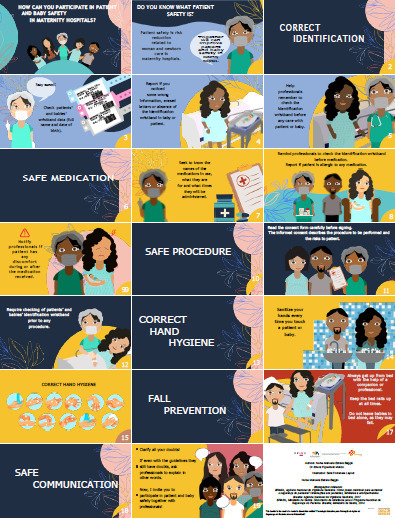
Search
Search in:
Nuvem de Tags
Enfermagem (930)Cuidados de Enfermagem (269)Atenção Primária à Saúde (239)Idoso (208)Educação em Enfermagem (151)Segurança do Paciente (150)Saúde Mental (145)Educação em Saúde (139)Estudos de Validação (131)Qualidade de Vida (104)Tecnologia Educacional (100)Promoção da Saúde (99)COVID-19 (91)Criança (91)Família (87)Enfermagem Pediátrica (86)Saúde do Trabalhador (86)Adolescente (85)Saúde Pública (82)Estudantes de Enfermagem (77)




